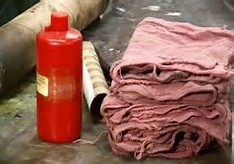Over 2.2 billion solvent-contaminated rags are used in workplaces in the United States on an annual basis. It is no surprise then that environment, health, and safety (EHS) managers must contend with requirements from both the U.S. Occupational Safety and Health Administration (OSHA) and the U.S. Environmental Protection Agency (EPA) for managing these rags. Yesterday we reviewed how OSHA wants you to deal with rags. Today we will take a look at options under the EPA for handling solvent-contaminated rags (or wipes, as the Agency refers to them).
 |
As an EHS manager, you have to make sure that your workers handle these rags safely, and you also must ensure their proper management for reuse or disposal.
In 2013, the EPA published a rule that allows some flexibility for managing solvent-contaminated wipes.
Note. Check with your state environmental agency to see if your state has adopted the Solvent-Contaminated Wipes final rule.
You Can Toss or Wash Wipes, If …
If you go through the waste determination process and figure out that the wipes are a solid or hazardous waste, and you decide to toss them, you can’t just throw them in the trash. If hazardous, you must contract with a treatment, storage, and disposal facility (TSDF) and a hazardous waste transporter (among other storage requirements) before you send them off. Make sure you don’t treat them yourself unless you want to be classified as a TSDF.
But here is where the federal rule provides you with some flexibility: Solvent-contaminated wipes that are determined to be hazardous are exempt from the definition of hazardous waste (and therefore can be thrown out), provided certain conditions are met concerning container management, a time limit, free liquids, recordkeeping, and the disposal facility to which the wipes are sent.
The key here is the solvent. If after you use the wipe, if it contains a F001–F005-listed solvent or its corresponding P- or U-listed solvent (check 40 CFR 261.31 and 40 CFR 261.33 to see if the solvent you use is a listed hazardous waste), it may be eligible for the exclusion from the definition of hazardous waste. In addition, you may be eligible for the exemption if (1) the solvent exhibits a hazardous characteristic resulting from being listed or (2) if it exhibits only the hazardous ignitability characteristic because of solvents that are not listed wastes. Just make sure that there are no free liquids in the wipes themselves or in the container holding them and that your wipes are not hazardous because of the presence of trichloroethylene. Wipes with trichloroethylene are ineligible for the exclusion from the definition of solid waste and must be managed as a hazardous waste.
The rule also provides flexibility should you decide to clean and reuse your wipes. Solvent-contaminated wipes sent for cleaning and reuse are exempt from being solid wastes provided certain conditions are met concerning container management, a time limit, free liquids, recordkeeping, and the laundry or dry-cleaning facility to which the wipes are sent.
So, here’s what to do if you’ve decided that the best option for managing your solvent-contaminated wipes is to get them exempt from EPA’s definition of solid (nonhazardous) and/or hazardous waste.
Step 1. Contract with an eligible laundry or landfill.
If your solvent-contaminated wipes are excluded from the solid waste definition, they must be sent for cleaning and reuse to a laundry or dry cleaner whose discharge, if any, is regulated under the Clean Water Act.
Solvent-contaminated wipes that are sent for disposal but are excluded from the definition of hazardous waste must be sent to a landfill that is either a municipal solid waste landfill or a hazardous waste landfill. Other options are to send the wipes to a municipal waste combustor or other combustion facility or to a hazardous waste combustor, boiler, or industrial furnace. Wherever you send them, make sure that the facility is following the regulations applicable to it.
The following Steps 2 through 5 apply to both the solid waste and hazardous waste exclusions.
Step 2. Set up containers.
Follow these instructions for containers used to accumulate, store, and transport solvent-contaminated wipes.
- The wipes must be contained in nonleaking, closed containers.
- The containers must be labeled “Excluded Solvent-Contaminated Wipes.”
- The containers must be able to contain free liquids should free liquids occur.
- The container must be sealed with all lids properly and securely affixed to the container and all openings tightly bound or closed to prevent leaks and emissions when any of the following occur:
- The container is full.
- When the solvent-contaminated wipes are no longer being accumulated.
- When the container is being transported.
Step 3. Observe time limits for accumulating solvent-contaminated wipes.
As a generator of solvent-contaminated wipes, you may accumulate the wipes for up to 180 days from the start date of accumulation for each container before being sent for cleaning or disposal.
Step 4. Say no to free liquids.
The solvent-contaminated wipes must contain no free liquids at the point of being sent for cleaning or disposal.
Note: Any free liquids removed from the solvent-contaminated wipes or from the container holding the wipes must be managed according to the applicable hazardous waste regulations.
Step 5. Keep good records.
As a generator, you must maintain at your site documentation that contains:
- Name and address of the laundry, dry cleaner, landfill, or combustor that is receiving the solvent-contaminated wipes;
- Documentation that the 180-day accumulation time limit in is being met; and
- Description of the process you are using to ensure the solvent-contaminated wipes contain no free liquids at the point of being transported for disposal.
Up to your eyeballs in hazardous waste? Check out Enviro.BLR.com’s Hazardous Waste Generator Resource Center for a variety of tools to help you manage the numerous responsibilities associated with being a generator of hazardous waste.
